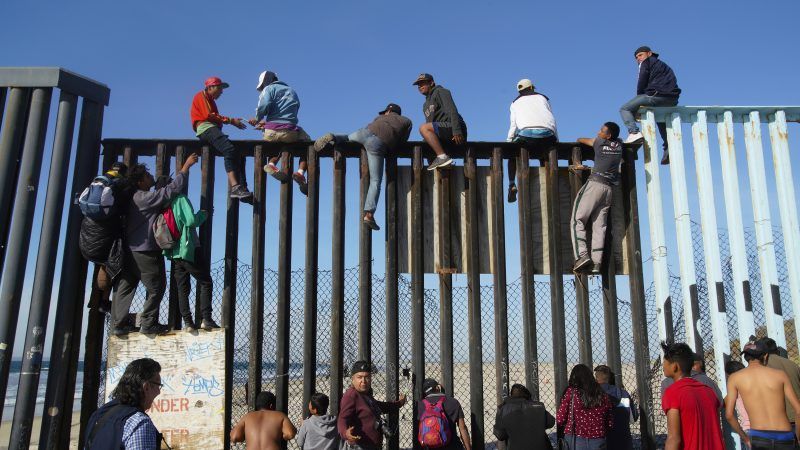A Viral Video Shows Why Border Walls Are Ineffective
Trump said mountain climbers couldn't scale his wall. All it takes is a ladder and some rope.

"We had…championship mountain climbers" who couldn't get over bolstered 30-foot border fencing, President Donald Trump told Fox News in September. No one, he said, could scale the structure.
A viral video circulating on social media shows a group of migrants climbing over the wall using a ladder and some rope.
And according to a recent Washington Post report, smugglers have been able to saw through the barrier using commonly available cordless saws (this is not a new phenomenon). All of these reports contradict Trump's claim that a border wall would be "virtually impenetrable."
Of course, the wall in 2019 looks much different than the one Trump promised during his 2016 campaign. It's made of steel bollards, as opposed to the "concrete plank" that he said would be financed by Mexico. And despite Trump claiming responsibility for building new stretches of border barrier, his administration has focused almost exclusively on renovating existing fencing.
Will fortifying fencing and building new barriers—at a conservative price estimate of $18 billion—meaningfully impact undocumented immigration and the smuggling of humans and drugs? It's actually tough to measure the wall's impact.
Border apprehensions for illegal entry and other offenses totaled 396,579 in 2018, down from 1,643,679 in 2000. In a statement, the Department of Homeland Security linked those lower apprehensions to the wall. "When it comes to stopping drugs and illegal aliens from crossing our borders, border walls have proven to be extremely effective," a statement said. "Border security relies on a combination of border infrastructure, technology, personnel and partnerships with law enforcement at the state, local, tribal, and federal level. For example, when we installed a border wall in the Yuma Sector, we have seen border apprehensions decrease by 90 percent."
Yet the vast majority of cocaine and heroin that arrives in the U.S. from Central and South America comes through legal ports of entry. It's also difficult to ascertain the role of barriers in reducing apprehensions. As David Bier of the Cato Institute notes in Reason, Congress implemented the Secure Fence Act in 2006, the same year they also bumped Border Patrol from 12,000 to 21,000 officers. Is the wall the deterrent? Or the patrols?
Even DHS concedes that a constellation of policies are at work, which undermines the case for investing so many billions of U.S. tax dollars in a wall, particularly when sections of that wall would require the confiscation of private property owned by U.S. citizens and building in desolate areas that only the hardiest and most desperate immigrants can cross without dying.
Bier also noted that apprehensions are down at least in part because immigrants have worked around the wall both figuratively and literally. In 2006, for instance, more than a third of undocumented immigrants came here by way of a visa overstay. By 2012, that number was up to 58 percent.
"It's not surprising that you put up a big wall somewhere, people go somewhere else," Bier tells me. "That's been true at least to some extent everywhere they've put up fences. People go around them if they can. In some cases, they go over them."



Show Comments (591)